
Concept explainers
(a)
Interpretation: The type of isomerism that could be exhibited by the given formulas.
An example that illustrates the specific type of isomerism is to be stated.
Concept introduction: Organic compounds which have similar chemical formula but different structures, i.e., the atoms are in a different spatial arrangement, they are known as structural isomers. Cis and Trans isomers are also structural or geometrical isomers.
To determine: The type of isomerism that could be exhibited by
(a)
Explanation of Solution
Explanation
The structural isomer of
The given formula,
The root word hexene indicates that six carbon atoms are present in the parent chain. Double bond is present between first and second carbon.
The structure of

Figure 1
The structural isomer of
The given formula,
The root word hexene indicates that six carbon atoms are present in the parent chain. The number
The structure of

Figure 2
The structural isomer of
The given formula,
The root word hexene indicates that six carbon atoms are present in the parent chain. The number
The structure of

Figure 3
The structural isomer of
The given formula,
The root word pentene indicates that five carbon atoms are present in the parent chain. The number
The structure of

Figure 4
The structural isomer of
The given formula,
The root word butene indicates that six carbon atoms are present in the parent chain. The double bond is present between second and third carbon. Two methyl groups are attached at second and third carbon.
The structure of

Figure 5
The geometric isomer of
The structure of cis-
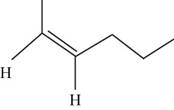
Figure 6
The structure of trans-

Figure 7
In the cis isomer, the two hydrogen of the double bonded carbons are adjacent to each other while in trans isomer, they are opposite to each other.
The geometric isomer of
The structure of cis-
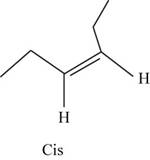
Figure 8
The structure of trans-
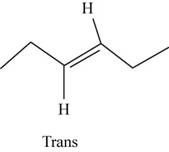
Figure 9
In the cis isomer, the two hydrogen of the double bonded carbons are adjacent to each other while in trans isomer, they are opposite to each other.
(b)
Interpretation: The type of isomerism that could be exhibited by the given formulas.
An example that illustrates the specific type of isomerism is to be stated.
Concept introduction: Organic compounds which have similar chemical formula but different structures, i.e., the atoms are in a different spatial arrangement, they are known as structural isomers. Cis and Trans isomers are also structural or geometrical isomers.
To determine: The type of isomerism that could be exhibited by
(b)
Explanation of Solution
Explanation
The root word pentane indicates that five carbon atoms are present in the parent chain. Hydroxyl group is attached to first carbon.
The structure of pentan-1-ol is shown in Figure 10.

Figure 10
The structural isomer of
The root word butane indicates that four carbon atoms are present in the parent chain.
The structure of

Figure 11
The structural isomer of
The root word propane indicates that three carbon atoms are present in the parent chain.
The structure of

Figure 12
The structural isomer of
The root word butane indicates that four carbon atoms are present in the parent chain.
The structure of
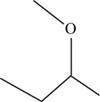
Figure 13
The structural isomer of
The root word pentane indicates that five carbon atoms are present in the parent chain. Hydroxyl group is attached to third carbon.
The structure of pentan-
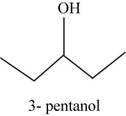
Figure 14
The structural isomer of
The root word pentane indicates that five carbon atoms are present in the parent chain. Hydroxyl group is attached to second carbon.
The structure of pentan-

Figure 15
(c)
Interpretation: The type of isomerism that could be exhibited by the given formulas.
An example that illustrates the specific type of isomerism is to be stated.
Concept introduction: Organic compounds which have similar chemical formula but different structures, i.e., the atoms are in a different spatial arrangement, they are known as structural isomers. Cis and Trans isomers are also structural or geometrical isomers.
To determine: The type of isomerism that could be exhibited by
(c)
Explanation of Solution
Explanation
The structural isomer of
In
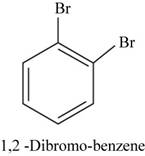
Figure 16
The structural isomer of
In
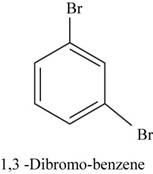
Figure 17
The structural isomer of
In
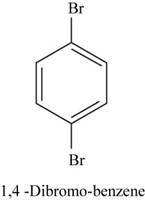
Figure 18
Want to see more full solutions like this?
Chapter 21 Solutions
Bundle: Chemistry: An Atoms First Approach, 2nd, Loose-Leaf + OWLv2, 4 terms (24 months) Printed Access Card
- Experiment 27 hates & Mechanisms of Reations Method I visual Clock Reaction A. Concentration effects on reaction Rates Iodine Run [I] mol/L [S₂082] | Time mo/L (SCC) 0.04 54.7 Log 1/ Time Temp Log [ ] 13,20] (time) / [I] 199 20.06 23.0 30.04 0.04 0.04 80.0 22.8 45 40.02 0.04 79.0 21.6 50.08 0.03 51.0 22.4 60-080-02 95.0 23.4 7 0.08 0-01 1970 23.4 8 0.08 0.04 16.1 22.6arrow_forward(15 pts) Consider the molecule B2H6. Generate a molecular orbital diagram but this time using a different approach that draws on your knowledge and ability to put concepts together. First use VSEPR or some other method to make sure you know the ground state structure of the molecule. Next, generate an MO diagram for BH2. Sketch the highest occupied and lowest unoccupied MOs of the BH2 fragment. These are called frontier orbitals. Now use these frontier orbitals as your basis set for producing LGO's for B2H6. Since the BH2 frontier orbitals become the LGOS, you will have to think about what is in the middle of the molecule and treat its basis as well. Do you arrive at the same qualitative MO diagram as is discussed in the book? Sketch the new highest occupied and lowest unoccupied MOs for the molecule (B2H6).arrow_forwardQ8: Propose an efficient synthesis of cyclopentene from cyclopentane.arrow_forward
- Q7: Use compound A-D, design two different ways to synthesize E. Which way is preferred? Please explain. CH3I ONa NaOCH 3 A B C D E OCH3arrow_forwardPredict major product(s) for the following reactions. Note the mechanism(s) of the reactions (SN1, E1, SN2 or E2).arrow_forward(10 pts) The density of metallic copper is 8.92 g cm³. The structure of this metal is cubic close-packed. What is the atomic radius of copper in copper metal?arrow_forward
- Predict major product(s) for the following reactions. Note the mechanism(s) of the reactions (SN1, E1, SN2 or E2).arrow_forwardPredict major product(s) for the following reactions. Note the mechanism(s) of the reactions (SN1, E1, SN2 or E2).arrow_forwardQ3: Rank the following compounds in increasing reactivity of E1 and E2 eliminations, respectively. Br ca. go do A CI CI B C CI Darrow_forward
- Q5: Predict major product(s) for the following reactions. Note the mechanism(s) of the reactions (SN1, E1, SN2 or E2). H₂O דיי "Br KN3 CH3CH2OH NaNH2 NH3 Page 3 of 6 Chem 0310 Organic Chemistry 1 HW Problem Sets CI Br excess NaOCH 3 CH3OH Br KOC(CH3)3 DuckDuckGarrow_forwardQ4: Circle the substrate that gives a single alkene product in a E2 elimination. CI CI Br Brarrow_forwardPlease calculate the chemical shift of each protonsarrow_forward
 ChemistryChemistryISBN:9781305957404Author:Steven S. Zumdahl, Susan A. Zumdahl, Donald J. DeCostePublisher:Cengage Learning
ChemistryChemistryISBN:9781305957404Author:Steven S. Zumdahl, Susan A. Zumdahl, Donald J. DeCostePublisher:Cengage Learning Chemistry: An Atoms First ApproachChemistryISBN:9781305079243Author:Steven S. Zumdahl, Susan A. ZumdahlPublisher:Cengage Learning
Chemistry: An Atoms First ApproachChemistryISBN:9781305079243Author:Steven S. Zumdahl, Susan A. ZumdahlPublisher:Cengage Learning


